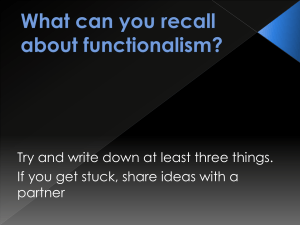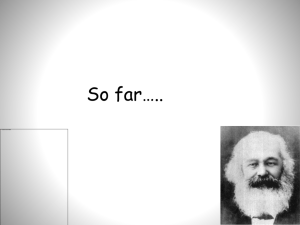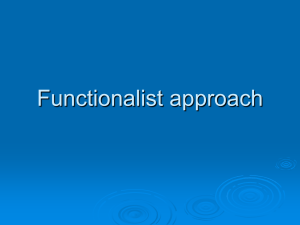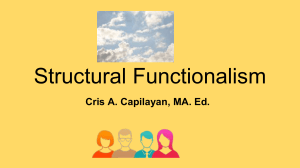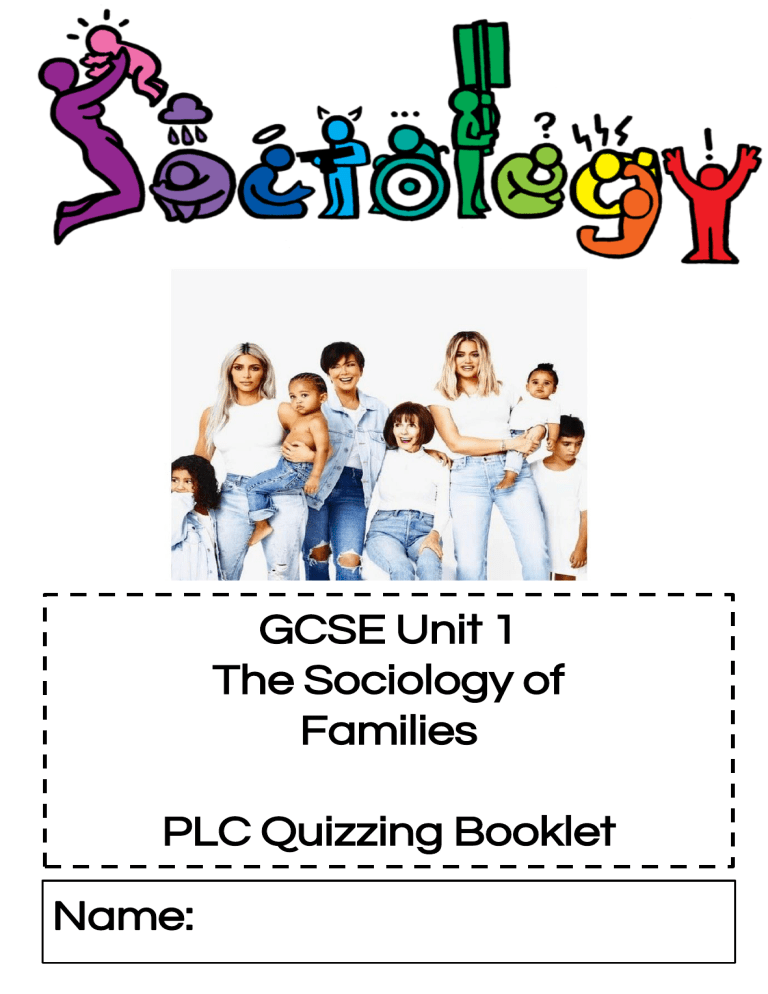
GCSE Unit 1 The Sociology of Families PLC Quizzing Booklet Name: PLC Point 1.1: Family Types A B C A group of people who whose relationship is based on marriage, civil partnership, cohabitation, blood 1 relations or adoption. Household Family Couple A group of unrelated adults living together. Household Family Couple A family that consists of a mother, father and their dependent children. Nuclear family Cereal packet Beanpole family family A family with multiple generations with few people at each level. Long 4 and thin in shape. Vertical extended family Horizontal extended family A family consisting of a couple where one or both of the partners have children from a previous relationship 5 living with them. Reconstituted Step family family A family where there are three generations or more living together or 6 nearby. Vertical extended family Horizontal extended family Same-sex family On-sex family Homosexual family Vertical extended family Horizontal extended family Beanpole family What is the most common family type found in Britain today? Step-families Nuclear Lone-parent Which is the fastest growing family form in Britain today? Step-families Nuclear Lone-parent 2 3 A family consisting of a gay or lesbian couple with their dependent children Beanpole family Blended family Beanpole family 7 A family where there are aunties, uncles or cousins living together or 8 close by. 9 10 Green 10-8 Amber 7-5 Red 4-0 Correct? PLC Point 1.1: Family Types Definition Family 1 Household 2 Nuclear 3 Beanpole 4 Reconstituted 5 Vertical extended 6 Same-sex 7 Horizontal extended 8 Lone-parent 9 Harder! Green 8-6 Amber 5-4 Red 3-0 Correct? PLC Point 1.2: Family Diversity A Which term describes when a society has lots of different family types? 1 Which family type is more common in the Asian community? 2 Which family type is more common in the African caribbean community? 3 What is a key difference between working class and middle class families? 4 Family differences Traditional gender roles One-person households Middle class families are more egalitarian (equal) B C Family Variation Family Diversity Lone-parent family Extended family Lone-parent family Extended family Middle class families use democratic parenting Middle class families are more likely to be nuclear The Rapoports Murdock Cultural diversity Organisational diversity Cultural diversity Organisational diversity Which sociologist researched family diversity? Parsons 5 6 7 8 9 10 Which form of diversity describes differences in family structures e.g family type and division of labour? Which form of diversity describes how families vary between ethnic and religious groups? Which form of diversity describes the stage at which people are in their lives e.g. newly-wed, retired? Which form of diversity describes how families differ according to the period of time they exist in? Which form of diversity describes how a family may be different according to the different resources available to them? Green 9-7 Amber 6-4 Life-course diversity Life-course diversity Life-course diversity Life-course diversity Organisational diversity Red 3-0 Social class Cohort diversity diversity Social class Cohort diversity diversity Social class Status diversity diversity Correct? PLC Point 1.2: Family Diversity Answer Which term describes when a society has lots of different family types? 1 Which family type is more common in the Asian community? 2 Which family type is more common in the African caribbean community? 3 What is a key difference between working class and middle class families? 4 Which sociologist researched family diversity? 5 6 Which form of diversity describes differences in family structures e.g family type and division of labour? Which form of diversity describes how families vary between ethnic and religious groups? 7 8 Which form of diversity describes the stage at which people are in their lives e.g. newly-wed, retired? Which form of diversity describes how families differ according to the period of time they exist in? 9 10 Which form of diversity describes how a family may be different according to the different resources available to them? Harder! Green 9-7 Amber 6-4 Red 3-0 Correct? PLC Point 1.3: Functionalist Perspective of the Family Which family type to Functionalist sociologists think is most ideal? 1 Which family type to Functionalist sociologists think is least ideal? 2 What are the 4 functions of the nuclear family as identified by Murdock? 3 What was Talcott Parsons’ overall argument about the nuclear family? 4 5 Which of Parsons’ functions is defined as the process by which children learn the norms and culture of their society? Which of Parsons’ functions is defined as the process by which adults are supported emotionally (warm bath 6 theory)? 7 Who do Functionalists believe benefits from the nuclear family performing vital functions? Who does Parsons believe is completing the functions the family once performed? 8 Why would Marxists criticise the Functionalist approach? 9 Why would Feminists criticise the Functionalist approach? 10 Green 10-7 Amber 6-4 A Lone-parent family Lone-parent family Education, Reproduction, Stabilisation of Adult Personalities, Economic It had lost functions over time Secondary socialisation The triple shift Society and capitalism External agencies e.g. NHS, social services It ignores how women are exploited in the family It ignores how women are exploited in the family Red 3-0 B C Nuclear Family Extended Family Nuclear Family Extended Family Economic, Sexual, Stabilisation of Adult Personalities, Socialisation Sexual, Reproduction, Economic, Education It had never It had been performed the 4 replaced by the functions lone-parent murdock family identified Primary socialisation Education function Stabilisation of emotional status Stabilisation of adult personalities Individuals and Capitalism and society individuals Lone parents It ignores how the nuclear family is being replaced by other family types It ignores how the nuclear family is being replaced by other family types Capitalism It ignores how the true beneficiary of the family is capitalism It ignores how the true beneficiaries of the family is capitalism Correct? PLC Point 1.3: Functionalist Perspective of the Family Answers Correct? Which family type to Functionalist sociologists think is most ideal? 1 Which family type to Functionalist sociologists think is least ideal? 2 What are the 4 functions of the nuclear family as identified by Murdock? 3 What was Talcott Parsons’ overall argument about the nuclear family? 4 5 6 Which of Parsons’ functions is defined as the process by which children learn the norms and culture of their society? Which of Parsons’ functions is defined as the process by which adults are supported emotionally? Who do Functionalists believe benefits from the nuclear family performing vital functions? 7 Who does Parsons believe is completing the functions the family once performed? 8 Why would Marxists criticise the Functionalist approach? 9 Why would Feminists criticise the Functionalist approach? 10 Harder! Green 10-7 Amber 6-4 Red 3-0 PLC Point 1.6: Conjugal Roles A B C Which term refers to the role a man performs as breadwinner and disciplinarian? Instrumental role 1 Expressive role Traditional man Expressive role Double-shift The roles men and women perform are natural and based on their biology The roles men and women perform help the family and society function smoothly Which term does Parsons use to refer to the role a woman performs in looking after the family emotionally? Instrumental role 2 How do Functionalists justify segregated conjugal roles? 3 What were the key features of Young and Wilmott’s symmetrical family? 4 Which of the following is a key reason Young and Wilmott use to explain the move to symmetry? 5 The roles men and women perform are are a social construction The family spend more leisure time together Feminism changed women’s expectations of homelife and worklife The man and wife made Men and women did the equal contributions to same jobs around the the home house Contraception meant that families were smaller and wanted to spend more time together The Equal Pay Act 1970 meant women went out to work in greater numbers and demanded equality in the home Stratified Diffusion Embourgeoisement The evidence is valid The claims they make are exaggerated Double shift Second shift They cherry pick the enjoyable aspects of childcare Men still do not do enough childcare Which term do Young and Wilmott use to describe how social changes happen in the middle class and filter down? Social class diffusion 6 How does Ann Oakley critique Young and Wilmott’s research? The claims they make are false 7 Which term refers to the feminist critique of women doing most of the housework and paid work outside of the home? Dual burden 8 What did Caroline Gatrell argue about men in the family? 9 They are playing a greater role in their children’s lives What do Scott and Cleary argue is the consequence of inequality at home? It holds women back in the workplace 10 What was Jan Pahl’s main argument about power and decision making in the family? 11 Men and women have equal say over financial decisions in the majority of relationships It means women are less It makes women resent likely to commit crime their partners Men use domestic violence as a way to have more power in relationships Men have more power than women over financial decisions Men and women have separate, defined roles Both men and women experience strain in the conventional family What were the key features of Ann Oakley’s conventional family? They are financially unequal 12 Green 10-7 Amber 6-4 Red 3-0 Correct ? PLC Point 1.6: Conjugal Roles ANSWER Correct? Which term refers to the role a man performs as breadwinner and disciplinarian? 1 Which term does Parsons use to refer to the role a woman performs in looking after the family emotionally? 2 How do Functionalists justify segregated conjugal roles? 3 What were the key features of Young and Wilmott’s symmetrical family? 4 Which of the following is a key reason Young and Wilmott use to explain the move to symmetry? 5 Which term do Young and Wilmott use to describe how social changes happen in the middle class and filter down? 6 How does Ann Oakley critique Young and Wilmott’s research? 7 Which term refers to the feminist critique of women doing most of the housework and paid work outside of the home? 8 What did Caroline Gatrell argue about men in the family? 9 What do Scott and Cleary argue is the consequence of inequality at home? 10 What was Jan Pahl’s main argument about power and decision making in the family? 11 What were the key features of Ann Oakley’s conventional family? 12 Green 12-9 Amber 8-5 Red 4-0 Harder!
